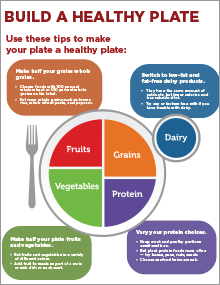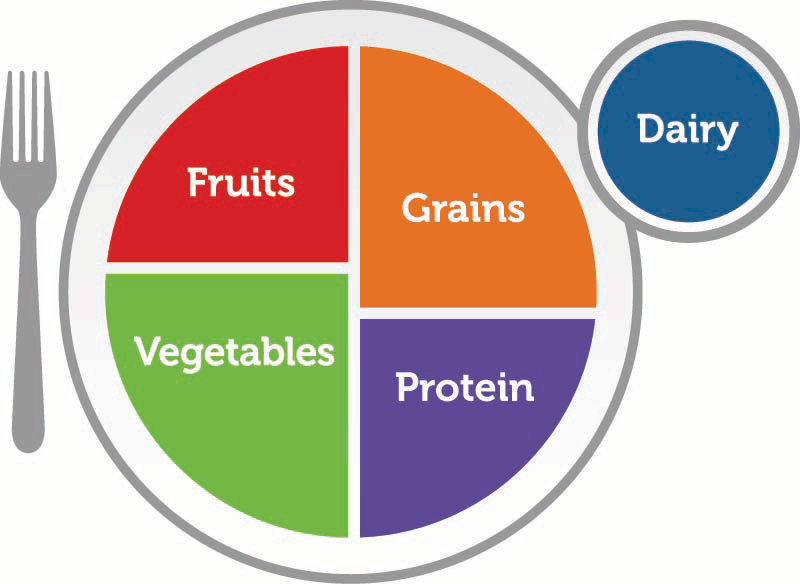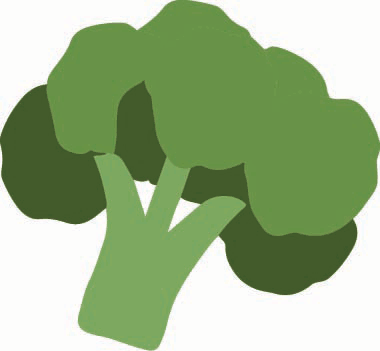Editor’s note
You can read this publication on this page or download the PDF.
See the companion publication N1044, Build a Healthy Plate Poster.

This poster highlights key messages of the dietary guidelines, including eating more fruits, vegetables, whole grains, and lower-fat dairy products; eating less sugar, fat, salt/sodium; varying protein choices; and balancing calories for weight maintenance. Using food labels to make better food choices and being physically active are also addressed.
The printed version is a two-page 8.5-by-11 inch handout.
See handout content below.
Build a Healthy Plate
Use these tips to make your plate a healthy plate.

Make half your grains whole grains
- Choose foods with 100 percent whole wheat or 100 percent whole grains on the label.
- Eat more whole grains such as brown rice, whole wheat pasta, and popcorn.
Switch to low-fat and fat-free dairy products
- They have the same amount of nutrients, but fewer calories and less saturated fat.
- Try soy or lactose free milk if you have trouble with dairy.

Make half your plate fruits and vegetables
- Eat fruits and vegetables in a variety of different colors.
- Add fruit to meals as part of a main or side dish or as dessert.
Vary your protein choices
- Keep meat and poultry portions small and lean.
- Eat plant protein foods more often — try beans, peas, nuts, seeds.
- Choose seafood twice a week.
Use food labels to help you make better choices
Most packaged foods have a Nutrition Facts label and an ingredient list.Use these to help you make smart food choices.
- Check serving sizes and how many servings you actually eat.
- Choose foods with fewer calories and less saturated fat, trans fat, sodium and sugar.
- Read the ingredient list to find whole-grain ingredients and added sugars.
Sip smarter
- Drink water instead of sugary drinks.
- Check the labels on your drinks for added sugar.
Eat more
- Fruits
- Vegetables
- Whole grains
- Low-fat and fat-free dairy products
Eat less
- Cut back on foods high in saturated fat, sodium and added sugar.
- Compare sodium in foods and choose foods with lower numbers.
- Limit extra gravies or sauces.
- Use oil instead of solid fat in cooking
- Choose water, unsweetened tea, or milk over sugary beverages.
- Use these foods as occasional treats, not everyday foods.
Eat the right amount of calories for you
- Balance your calories with physical activity.
- Enjoy your food, but be mindful of portion sizes.
- Eat slowly and take the time to enjoy your food.
- A smart trick to control portion sizes — use a smaller bowl or plate, and always portion out snacks rather than eating straight from the bag or box.
- Pay attention to hunger and fullness cues — stop eating when you are satisfied, not full.
- Eat at home more often. This makes it easier to eat healthier, and it also saves money!
- Check out the nutrition information for your meal when you do eat out so you can make an informed decision.
Funded in part by USDA SNAP.
For more information, call MU Extension’s Show Me Nutrition line at 1-888-515-0016.
Need help stretching your food dollars? Contact your local resource center or go online to mydss.mo.gov/food-assistance/food-stamp-program.